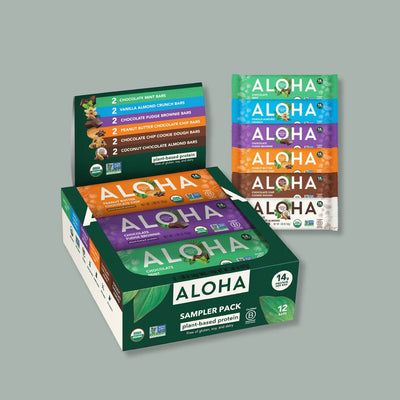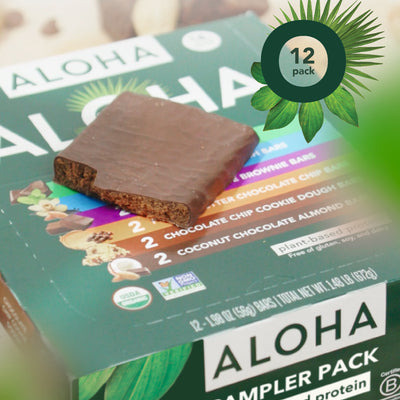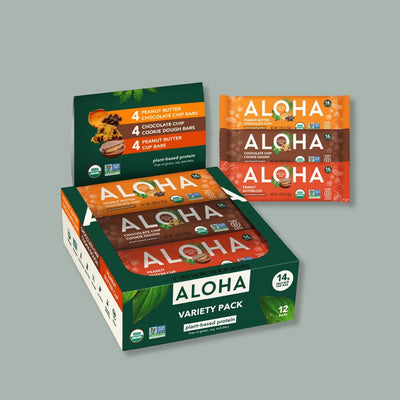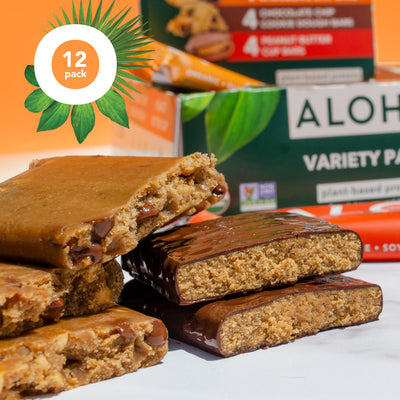Key Takeaways:
- Not All Protein Bars Are Kid-Friendly: Many protein bars are made for adults and contain high protein levels and artificial ingredients that aren’t suitable for kids. Choosing bars with organic, whole-food ingredients ensures a healthier option.
- Protein Bars Should Be a Snack, Not a Meal Replacement: Protein bars work best as on-the-go snacks rather than a full meal substitute. Kids need a variety of nutrients from whole foods to support their growth and development.
- ALOHA Protein Bars Are a Healthy Option for Kids: ALOHA’s mini protein bars are organic, plant-based, and free from artificial sweeteners, making them a great choice for kids. Their moderate protein and clean ingredients make them both nutritious and delicious.
Is your child always on the move and needs a quick and nutritious snack? Protein bars seem convenient, but not all are designed with kids in mind—some contain artificial ingredients, excess sugar, or more protein than a child needs.
At ALOHA, clean, organic, and plant-based nutrition should be accessible to everyone, including kids. Our protein bars are crafted with simple, wholesome ingredients, free from artificial sweeteners, soy, and dairy—because healthy snacking should never be a compromise.
In this piece, we’ll explore whether kids can safely eat protein bars, what to look for in a kid-friendly option, and highlight the best choices. Let’s help you find a protein bar that’s both nutritious and kid-approved!
Can Kids Eat Protein Bars? Understanding The Basics
Protein bars are often marketed as a convenient source of energy and nutrition, but are they actually suitable for kids? The answer depends on the ingredients, protein content, and a child’s dietary needs. While adults may need higher protein intake for recovery and energy, children typically get enough from a balanced diet that includes whole foods like beans, nuts, dairy, and lean meats.
The key is to choose protein bars made with natural, whole-food ingredients that support a child’s growth without unnecessary additives. Many commercial bars contain excessive protein, artificial sweeteners, and preservatives that aren’t ideal for a young digestive system. Instead, plant-based, organic bars with moderate protein levels and minimal added sugars make a much better choice.
What To Look For In A Kid-Friendly Protein Bar
When choosing a protein bar for kids, it’s essential to look beyond the marketing claims and focus on the ingredients. Many bars are formulated for adults and contain high protein levels, artificial additives, and sugar alcohols that may not be suitable for young digestive systems. Instead, parents should look for a balanced option that provides energy, fiber, and essential nutrients in a natural way:
- Whole, Organic Ingredients Matter: The best protein bars for kids are made from real, recognizable ingredients like oats, nuts, seeds, and plant-based protein sources. These provide natural energy, fiber, and healthy fats that support a child’s growth without unnecessary additives. Organic certification is also a plus, as it ensures the ingredients are free from pesticides and harmful chemicals.
- Avoid Artificial Sweeteners and Sugar Alcohols: Many protein bars contain artificial sweeteners such as sucralose or sugar alcohols like erythritol to lower sugar levels. However, these ingredients may lead to digestive issues in children and encourage a preference for excessively sweet flavors. Opt for bars that use natural sweeteners like coconut sugar for a milder, more kid-friendly taste.
- Moderate Protein for Growing Bodies: While protein is essential for growth, kids don’t need as much as adults or athletes. Bars with 5-10 grams of protein per serving offer a balanced amount without overloading their system. Excessive protein, especially from processed sources, can be hard on a child’s kidneys and may lead to unnecessary calorie intake.
- Minimal Added Sugars for Healthy Energy: Too much added sugar can lead to energy crashes, mood swings, and long-term health issues. Some protein bars pack 10-15 grams of added sugar, which is nearly half the daily limit for young kids. Choosing a bar with low natural sugars (under 8g) and high fiber helps provide steady energy without the sugar rush.
- Short and Simple Ingredient Lists: A general rule of thumb: if you can’t pronounce it, your child probably shouldn’t be eating it. Kid-friendly protein bars should have a short, easy-to-read ingredient list with whole foods you recognize. The fewer the ingredients, the less processed the bar, making it a healthier snack choice.
The Best Protein Bars For Kids: Healthy & Delicious Options
Choosing the right protein bar for your child involves selecting products that are nutritious, tasty, and made with wholesome ingredients. Here are some top picks from ALOHA that fit the bill:
- Peanut Butter Cup Mini Bar: This mini bar offers 6g of plant-based protein and 4g of fiber in a 100-calorie serving, combining a rich chocolate coating with savory peanut butter filling. It's free from gluten, dairy, soy, stevia, and sugar alcohol sweeteners, making it a wholesome choice for kids.
- Chocolate Caramel Pecan Mini Bar: Packed with 6g of plant-based protein, this mini bar blends organic dark chocolate with real pecans for a subtly sweet treat. At just 100 calories, it's a delightful snack that provides healthy fats and fiber to energize kids.
- Chocolate Chip Cookie Dough Mini Protein Bar: This bar delivers 6g of organic plant-based protein and 4g of fiber in a 100-calorie serving, featuring a delicious combination of chocolate chips and cookie dough flavor. It's vegan, gluten-free, and made with simple, recognizable ingredients.
- Coconut Chocolate Almond Mini Protein Bar: This mini bar combines the tropical taste of coconut with rich chocolate and crunchy almonds. It provides 6g of plant-based protein and healthy fats. It's a satisfying snack that supports a balanced diet for active kids.
- Peanut Butter Chocolate Chip Mini Protein Bar: This bar offers a classic flavor combination, 6g of plant-based protein, and 4g of fiber, making it a nutritious option for kids. At 100 calories, it's a convenient snack free from artificial additives.
These ALOHA mini protein bars are crafted with organic, non-GMO ingredients, ensuring a clean and healthy snack option that kids will love.
How Much Protein Do Kids Really Need?
Protein is essential for a child’s growth, development, and overall health, but how much is too much? Many protein bars on the market are designed for adults and athletes, often containing more protein than a child actually needs in a single serving. Understanding the right amount of protein for kids can help parents make better snack choices:
Recommended Daily Protein Intake For Kids
A child's protein needs vary by age, activity level, and diet. According to nutrition guidelines, the recommended daily protein intake is:
- Toddlers (1-3 years old) → 13g per day
- Young children (4-8 years old) → 19g per day
- Older children (9-13 years old) → 34g per day
These numbers show that kids generally meet their protein needs through balanced meals, so high-protein bars aren’t always necessary.
Can Too Much Protein Be Harmful?
While protein is beneficial, excessive amounts may strain a child’s kidneys and digestive system. High-protein diets can lead to dehydration and may cause an imbalance if they replace essential carbohydrates and fats in a child’s diet. This is why it’s best to choose moderate-protein bars (5-10g per serving) instead of those with 20g or more.
Where Should Kids Get Their Protein?
Kids should ideally get protein from various whole foods, including beans, lentils, nuts, seeds, dairy, eggs, and whole grains. Protein bars can be a great on-the-go snack but shouldn’t replace meals or whole-food protein sources. Instead, they should complement a balanced diet and provide a quick, nutritious boost when needed.
Best Times For Kids To Eat Protein Bars: Snack Or Meal?
Protein bars can be a convenient snack for kids, but should they be eaten as a meal replacement or just as an in-between snack? While they can provide a quick energy boost, they should not replace a well-balanced meal, especially for growing children. Instead, protein bars work best when used strategically throughout the day to support a child’s nutrition.
A Smart On-The-Go Snack
Busy mornings, after-school activities, and weekend outings often leave little time for proper meals. Protein bars can serve as a quick and nutritious snack between meals, providing a steady energy source without the sugar crashes of traditional processed snacks. A mini protein bar or half of a full-sized bar is usually enough to satisfy kids until their next meal.
Post-Activity Refuel
Kids need to replenish their energy and support recovery after an active day at school, sports practice, or outdoor play. A protein bar with 5-10g of protein and a balance of healthy fats and fiber can help refuel their bodies while keeping hunger in check. Pairing it with a piece of fruit or a glass of milk can make it an even more balanced recovery snack.
Fun Ways To Make Protein Bars More Appealing To Kids
Even the healthiest protein bars won’t do much good if your child doesn’t enjoy eating them. Some kids might be hesitant to try them, especially if they’re used to traditional sweet snacks. The key is to get creative and present protein bars in fun and exciting ways that make them more appealing:
- Cut Them into Bite-Sized Pieces: Instead of giving your child a whole bar, try cutting it into small, bite-sized squares. Arrange them like little treats on a plate, or mix them with other healthy snacks like nuts and fruit. Turning a protein bar into "snack bites" makes it feel less like a meal replacement and more like a fun treat.
- Pair with a Favorite Dip: Kids love dipping their snacks! Try pairing a protein bar with nut butter, Greek yogurt, or a fruit-based dip to enhance the flavor and make snack time more interactive. Dipping adds extra nutrients and makes the experience feel more like a fun dessert than just eating a bar.
- Freeze for a Cool, Crunchy Treat: For a refreshing twist, freeze a protein bar for an hour to give it a firmer, chewier texture. This works especially well for chocolate-coated bars, turning them into a cool, ice-cream-like snack on hot days. Kids will enjoy the novelty of having a "frozen treat" that’s still healthy and nutritious.
- Crumble Over Yogurt or Oatmeal: If your child enjoys yogurt or oatmeal, try crumbling a mini protein bar on top for added texture and flavor. This turns the bar into a fun topping rather than the main focus of the snack, making it more enjoyable for picky eaters. Plus, it adds extra protein and fiber to their meal.
- Turn It Into a Fun "Dessert": Make protein bars feel like a special treat by cutting them into shapes or decorating them with a light drizzle of melted dark chocolate, almond butter, or a sprinkle of shredded coconut. Presenting them as a dessert rather than just a snack can excite kids to eat them more.
Using these fun tricks, parents can make protein bars feel less like a "healthy food" and more like an enjoyable part of snack time. Creativity can go a long way in making nutritious options more kid-friendly!
Final Thoughts
When it comes to kids and protein bars, balance is key. While these bars can be convenient, they should be chosen carefully to align with a child's nutritional needs. Not all protein bars are created with kids in mind; some contain unnecessary additives, excessive protein, or too much sugar. The best options prioritize simple, whole-food ingredients that support steady energy and healthy growth. At the end of the day, protein bars can be a useful part of a child’s diet, but they should complement—rather than replace—nutritious, whole-food meals. Making informed choices ensures that kids get the nourishment they need and the flavors they enjoy.
Read also:
- Protein Cookie Recipe: Delicious And High-Protein Treats
- Protein Waffle Recipe: Tasty And High-Protein Breakfast
- Protein Muffin Recipe: Easy Snacks Packed With Protein
Frequently Asked Questions About Can Kids Eat Protein Bars
Are protein bars safe for kids?
Yes, as long as they are made with natural, whole-food ingredients and have moderate protein content. Avoid bars with artificial sweeteners or sugar alcohols.
At what age can kids start eating protein bars?
Most kids over the age of four can safely eat protein bars in moderation, provided they contain child-friendly ingredients. Younger children should get most of their protein from whole foods.
Can kids eat protein bars every day?
It’s fine for kids to have a protein bar as an occasional snack, but they shouldn’t replace balanced meals. A variety of whole foods should be the main source of their nutrition.
Do protein bars help kids with growth and development?
Protein is essential for growth, but most children get enough from their regular diet. A protein bar can support daily protein intake but should not replace whole foods.
Can kids eat protein bars before bed?
Yes, but it’s best to choose bars with minimal sugar and without stimulants like caffeine. Eating too much sugar before bed may make it harder for some children to wind down.
Are ALOHA protein bars a good option for kids?
Yes! ALOHA protein bars are organic, plant-based, and free from artificial additives, making them a kid-friendly option when eaten in moderation.
Do kids need protein bars if they already eat meat and dairy?
Not necessarily, but a protein bar can be a convenient snack for busy schedules. If a child eats a balanced diet, protein bars should be considered a supplement, not a necessity.
Can protein bars cause digestive issues in kids?
Some bars contain sugar alcohols or artificial ingredients that may cause bloating or stomach discomfort. Choosing bars made with organic, whole-food ingredients helps avoid this issue.
What should I look for when choosing a protein bar for my child?
Look for organic, plant-based ingredients with moderate protein (5–10g), low sugar, and no artificial sweeteners or sugar alcohols. ALOHA mini protein bars are a great kid-friendly option.
Can kids eat protein bars before or after sports practice?
Yes, protein bars can be a great pre- or post-workout snack for active kids. They provide a quick source of fuel or post-activity nourishment when paired with other whole foods.
Sources:
1. Maria Elena Capra, Stanyevic, B., Giudice, A., Monopoli, D., Nicola Mattia Decarolis, Esposito, S., & Giacomo Biasucci. (2024). Nutrition for Children and Adolescents Who Practice Sport: A Narrative Review. Nutrients, 16(16), 2803–2803. https://doi.org/10.3390/nu16162803
2. Endrinikapoulos, A., Diana Nur Afifah, Mexitalia, M., Robi Andoyo, Ihat Hatimah, & Nuryanto Nuryanto. (2023). Study of the importance of protein needs for catch-up growth in Indonesian stunted children: a narrative review. Sage Open Medicine, 11, 205031212311655-205031212311655. https://doi.org/10.1177/20503121231165562
3. Mäkinen, K. K. (2016). Gastrointestinal Disturbances Associated with the Consumption of Sugar Alcohols with Special Consideration of Xylitol: Scientific Review and Instructions for Dentists and Other Health-Care Professionals. International Journal of Dentistry, 2016, 1–16. https://doi.org/10.1155/2016/5967907
4. Hudson, J. L., Baum, J. I., Diaz, E. C., & Børsheim, E. (2021). Dietary Protein Requirements in Children: Methods for Consideration. Nutrients, 13(5), 1554. https://doi.org/10.3390/nu13051554
5. Faizan, U., & Rouster, A. S. (2023). Nutrition and Hydration Requirements In Children and Adults. PubMed; StatPearls Publishing. https://www.ncbi.nlm.nih.gov/books/NBK562207/
6. Michaelsen, K. F., & Greer, F. R. (2014). Protein needs early in life and long-term health. The American Journal of Clinical Nutrition, 99(3), 718S722S. https://doi.org/10.3945/ajcn.113.072603
ALOHA's products are not intended to treat, diagnose, mitigate, prevent, or cure disease. ALOHA's products should not replace prescribed medications or the variety of foods important to a healthful diet.
Do not self-diagnose any health condition. Work with your healthcare provider to determine how best to achieve optimal health.












